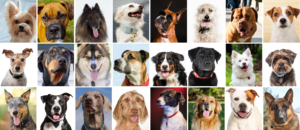To best understand this article in the context of the Breeds and Behavior literature, please see National Canine Research Council’s complete analysis here.
Starling, M. J., Branson, N., Thomson, P. C., & McGreevy, P. D. (2013). “Boldness” in the domestic dog differs among breeds and breed groups. Behavioural Processes, 97, 53-62. doi: https://doi.org/10.1016/j.beproc.2013.04.008.
The purpose of this 2013 study was to assess the bold-shy trait, across many breeds and several breed groups. It is included here because it is an attempt to uncover commonalities within breed groups whose historical function is actually topographically similar, rather than simply a traditional grouping based on kennel club folklore and tradition. Unfortunately, the study suffers from the use of an unvalidated instrument, unverified breed identification for the subjects, and no means of separating respondents’ breed based expectations of their dogs’ behavior from the actual behavior.
“Boldness,” the stated behavioral category of interest, is described as a “super trait,” meaning that it represents one end of a hypothetical continuum (shy/bold) which is described as encompassing a variety of other traits that appear in the literature, though there is not general agreement about the existence or description of this trait. The authors hypothesize that this shy/bold continuum is related to another hypothetical “super-trait” continuum, the “coping styles” axis which puts behaviors described as proactive at one end, and those described as reactive at the other.
The authors describe different styles of coping as how an animal responds to stress. Coping styles are described by the authors as consistent over time and as traits that can be used to group individuals. “Proactive coping” is considered inflexible and is expressed as actively trying to cope with a stressful stimulus and translates to “boldness” or “friendliness,” but sometimes also, “aggression.” “Reactive coping” is the opposite; environmental cues are used to drive behavior, behavior is flexible, and the animal tends to avoid the stressful stimulus. “Reactive” in this context corresponds to “shyness” or “fearfulness.”
The authors created their own owner survey by picking items they considered to be related to boldness from the Canine Behavioral Assessment and Research Questionnaire (C-BARQ), and from Svartberg’s (2002 & 2005) survey on play behavior, and questions composed by these authors that they considered revealing of proactive and reactive behavior. This yields an instrument that eliminates any possible claims of validation. Because a previous attempt to establish convergent validation between the Dog Mentality Assessment and the C-BARQ had failed to establish a correlation among questions or tests related to aggression (Svartberg, 2005), stranger-directed aggression was omitted. The survey was administered to dog owners in Australia via email and internet forums which yielded 1,054 usable responses. As is usually the case with internet surveys, there was no verification of the owner-reported breeds of the dogs. Moreover, dogs reported as “mixed” were sometimes lumped into one of the breed group categories, based on the respondent’s report of the dog’s multiple breed ancestry, a mechanism that is unlikely to be accurate. And since the surveys were not directed at members of specific breed clubs where members might be more likely that the average pet owner to know the pedigree status of their pet, the breed identification here is at the weakest level among the studies we have included in this library. Thus the difficulties with the instrument were compounded by issues with the sample itself.
A principal components analysis (PCA) showed that stranger-directed interest (such as approaching unfamiliar children in a friendly manner and greeting unfamiliar visitors in the home) as well as human-directed play interest and dog-directed interest were associated with the trait “boldness”. Conversely, stranger-directed fear and dog-directed fear were associated with “shyness”.
Despite size not being included in the survey, size was included in the analyses; reported purebreds were categorized (small, medium, large, giant) according to data on “preferred height” for the breed standards in the Australian National Kennel Club. This is speculative at best, since the breed identification itself is suspect, and thus allows little foundation for drawing any correlations between size and behavior. They then reported a strong correlation between breed group and size (this is a rather circular finding, since they used breed group to determine “size”) and thus constructed two linear mixed models (one with breed group and the other with size).
The authors reported significant breed and traditional breed group differences for “boldness” versus “shyness, but did not find support for their original hypotheses of a connection between this axis and the coping styles axis. Moreover, the 3 breeds reported as boldest were not from the same traditional breed groups, much less the same subgroups the authors had categorized as having real functional similarities. Yet the authors interpret the differences as evidence that the historical purposes for which dogs were bred may still impact modern behavior.
The common issue of grouping dogs based on behavior without objectively evaluating behavior remains a weakness in this study and others like it. Owners’ perceptions, memories, and interpretations of their dogs’ behaviors were analyzed, not the behaviors themselves. As is typical of such studies, the authors acknowledge that there is no way to determine what role owners’ confirmation biases (based on their breed-related expectations of their dogs) influenced their responses on the questionnaire or their own behavior forming husbandry practices. And in this case, the categorization of the behaviors of interest is complex and so much in flux that the authors finally conclude that “boldness” may not even be the right name for it. The first principle of any psychometric measurement instrument is that you must first be able to clearly define what you are measuring.
https://doi.org/10.1016/j.beproc.2013.04.008
Svartberg, K. (2002). Shyness–boldness predicts performance in working dogs. Applied Animal Behaviour Science, 79(2), 157-174.
Svartberg, K. (2005). A comparison of behaviour in test and in everyday life: evidence of three consistent boldness-related personality traits in dogs. Applied Animal Behaviour Science, 91(1), 103-128.
Page last updated July 17, 2019





